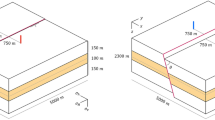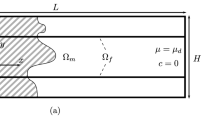Abstract
Simulation of fracturing processes in porous rocks can be divided into two main branches: (i) modeling the rock as a continuum enhanced with special features to account for fractures or (ii) modeling the rock by a discrete (or discontinuous) approach that describes the material directly as a collection of separate blocks or particles, e.g., as in the discrete element method (DEM). In the modified discrete element (MDEM) method, the effective forces between virtual particles are modified so that they reproduce the discretization of a first-order finite element method (FEM) for linear elasticity. This provides an expression of the virtual forces in terms of general Hook’s macro-parameters. Previously, MDEM has been formulated through an analogy with linear elements for FEM. We show the connection between MDEM and the virtual element method (VEM), which is a generalization of FEM to polyhedral grids. Unlike standard FEM, which computes strain-states in a reference space, MDEM and VEM compute stress-states directly in real space. This connection leads us to a new derivation of the MDEM method. Moreover, it enables a direct coupling between (M)DEM and domains modeled by a grid made of polyhedral cells. Thus, this approach makes it possible to combine fine-scale (M)DEM behavior near the fracturing region with linear elasticity on complex reservoir grids in the far-field region without regridding. To demonstrate the simulation of hydraulic fracturing, the coupled (M)DEM-VEM method is implemented using the Matlab Reservoir Simulation Toolbox (MRST) and linked to an industry-standard reservoir simulator. Similar approaches have been presented previously using standard FEM, but due to the similarities in the approaches of VEM and MDEM, our work provides a more uniform approach and extends these previous works to general polyhedral grids for the non-fracturing domain.
Similar content being viewed by others
References
Aavatsmark, I.: An introduction to multipoint flux approximations for quadrilateral grids. Comput. Geosci. 6(3-4), 405–432 (2002)
Alassi, H., Holt, R., Landrø, M.: Relating 4d seismics to reservoir geomechanical changes using a discrete element approach. Geophys. Prospect. 58(4), 657–668 (2010)
Alassi, H.T.: Modeling reservoir geomechanicsusing discrete element method: Application to reservoir monitoring. PhD thesis NTNU (2008)
Alassi, H.T., Holt, R.: Relating discrete element method parameters to rock properties using classical and micropolar elasticity theories. Int. J. Numer. Anal. Methods Geomech. 36(10), 1350–1367 (2012)
Allman, D.J.: Special memorial issue a compatible triangular element including vertex rotations for plane elasticity analysis. Computers & Structures 19(1), 1–8 (1984)
Andersen, O., Nilsen, H.M., Raynaud, X.: Virtual element method for geomechanical simulations of reservoir models. Comput. Geosci. (2017)
Bergan, P.G., Nygård, M.K.: Free formulation elements applied to stability of shells. Comput. Mech. (1988)
Bergan, P.G., Nygård, M.K., Bjærum, R.O.: Chapter Free Formulation Elements with Drilling Freedoms for Stability Analysis of shells: Computational Mechanics of Nonlinear Response of Shells, pp 164–182. Springer, Berlin (1990)
Biot, M.A.: General theory of three-dimensional consolidation. J. Appl. Phys. 12(2), 155–164 (1941)
Cook, R.D.: On the allman triangle and a related quadrilateral element. Comput. Struct. 22(6), 1065–1067 (1986)
Cundall, P.A., Strack, O.D.L.: A discrete numerical model for granular assemblies. Gé,otechnique 29 (1), 47–65 (1979)
da Veiga, L.B., Lipnikov, K., Manzini, G.: Mimetic Finite Difference Method for Elliptic Problems, volume 11. Springer (2014)
Dvorkin, J., Nur, A.: Elasticity of high-porosity sandstones Theory for two north sea data sets. Geophysics 61(5), 1363–1370 (1996)
Felippa, C.A.: A study of optimal membrane triangles with drilling freedoms. Comput. Methods Appl. Mech. Eng. 192(16-18), 2125–2168 (2003)
Gain, A.L., Talischi, C., Paulino, G.H.: On the virtual element method for three-dimensional linear elasticity problems on arbitrary polyhedral meshes. Comput. Methods Appl. Mech. Eng. 282, 132–160 (2014)
Griffith, A.A.: The phenomena of rupture and flow in solids. Philosophical Transactions of the Royal Society of London A: Mathematical, Physical and Engineering Sciences 221(582-593), 163–198 (1921)
Gringarten, E.J., Arpat, G.B. , Haouesse, M.A., Dutranois, A., Deny, L., Jayr, S., Tertois, A.-L., Mallet, J.-L., Bernal, A., Nghiem, L.X.: New grids for robust reservoir modeling SPE Annual Technical Conference and Exhibition (2008)
Haga, J.B., Osnes, H., Langtangen, H.P.: On the causes of pressure oscillations in low-permeable and low-compressible porous media. Int. J. Numer. Anal. Methods Geomech. 36(12), 1507–1522 (2012)
Hehl, F.W., Itin, Y.: The cauchy relations in linear elasticity theory. Journal of elasticity and the physical science of solids 66(2), 185–192 (2002)
Helbig, K.: Review paper: What kelvin might have written about elasticity. Geophys. Prospect. 61(1), 1–20 (2013)
Hughes, T.J.R., Brezzi, F.: On drilling degrees of freedom. Comput. Methods Appl. Mech. Eng. 72(1), 105–121 (1989)
Hughes, T.J.R., Masud, A., Harari, I.: Numerical assessment of some membrane elements with drilling degrees of freedom. Comput. Struct. 55(2), 297–314 (1995)
International Energy Agency: (2015)
Jing, L., Hudson, J.A.: Numerical methods in rock mechanics. Int. J. Rock Mech. Min. Sci. 39(4), 409–427 (2002)
Krogstad, S., Lie, K.-A., Møyner, O., Nilsen, H.M., Raynaud, X., Skaflestad, B., et al.: Mrst-ad–an open-source framework for rapid prototyping and evaluation of reservoir simulation problems SPE reservoir simulation symposium. Society of Petroleum Engineers (2015)
Kuna, M.: Finite elements in fracture mechanics Solid Mechanics and Its Applications (2013)
Li, Q., Xing, H., Liu, J., Liu, X.: A review on hydraulic fracturing of unconventional reservoir. Petroleum 1(1), 8–15 (2015)
Lie, K.-A., Krogstad, S., Ligaarden, I.S., Natvig, J.R., Nilsen, H., Skaflestad, B.: Open-source MATLAB implementation of consistent discretisations on complex grids. Comput. Geosci. 16, 297–322 (2012)
Lisjak, A., Grasselli, G.: A review of discrete modeling techniques for fracturing processes in discontinuous rock masses. J. Rock Mech. Geotech. Eng. 6(4), 301–314 (2014)
Mallison, B., Sword, C., Viard, T., Milliken, W., Cheng, A.: Unstructured cut-cell grids for modeling complex reservoirs. SPE J. 19(02), 340–352 (2014)
Mindlin, R.D.: Compliance of elastic bodies in contact. J. Applied Mechanics 16, 259–268 (1949)
Mott, P.H., Roland, C.M.: Limits to poisson’s ratio in isotropic materials-general result for arbitrary deformation. Physica Scripta 87(5), 055404 (2013)
The MATLAB Reservoir Simulation Toolbox, version 2016b, 12 (2016)
Nejati, M., Paluszny, A., Zimmerman, R.W.: On the use of quarter-point tetrahedral finite elements in linear elastic fracture mechanics. Eng. Fract. Mech. 144, 194–221 (2015)
Pachauri, R.K., Meyer, L.: Climate change 2007: synthesis report. summary for policymakers IPCC (2014)
Pan, X. D., Reed, M.B.: A coupled distinct element-finite element method for large deformation analysis of rock masses. Int. J. Rock Mech. Min. Sci. Geomech. Abstr. 28(1), 93–99 (1991)
Pavlov, I.S., Potapov, A.I., Maugin, G.A.: A 2d granular medium with rotating particles. Int. J. Solids Struct. 43(20), 6194–6207 (2006)
Ponting, D.K.: Corner point geometry in reservoir simulation ECMOR I-1st European Conference on the Mathematics of Oil Recovery (1989)
Schubert, W., Essen, E.d. (eds.): Novel Approach to Studying Rock Damage: The Three Dimensional Adaptive Continuum / Discontinuum Code. Verlag Glückauf, Salzburg (2004)
Suiker, A.S.J., Metrikine, A.V., de Borst, R.: Comparison of wave propagation characteristics of the cosserat continuum model and corresponding discrete lattice models. Int. J. Solids Struct. 38(9), 1563–1583 (2001)
Walton, K.: The effective elastic moduli of a random packing of spheres. J. Mech. Phys. Solids 35(2), 213–226 (1987)
Shen, R.W.U., Lei, G.U.: Introduction to the explicit finite element method for nonlinear transient dynamics. Wiley (2012)
Zienkiewicz, O.C., Zhu, J.Z.: The superconvergent patch recovery and a posteriori error estimates. part 1: The recovery technique. Int. J. Numer. Methods Eng. 33(7), 1331–1364 (1992)
Acknowledgments
This publication has been produced with support from the KPN project Controlled Fracturing for Increased Recovery. The authors acknowledge the following partners for their contributions: Lundin and the Research Council of Norway (244506/E30).
Author information
Authors and Affiliations
Corresponding author
Rights and permissions
About this article
Cite this article
Nilsen, H.M., Larsen, I. & Raynaud, X. Combining the modified discrete element method with the virtual element method for fracturing of porous media. Comput Geosci 21, 1059–1073 (2017). https://doi.org/10.1007/s10596-017-9668-6
Received:
Accepted:
Published:
Issue Date:
DOI: https://doi.org/10.1007/s10596-017-9668-6




